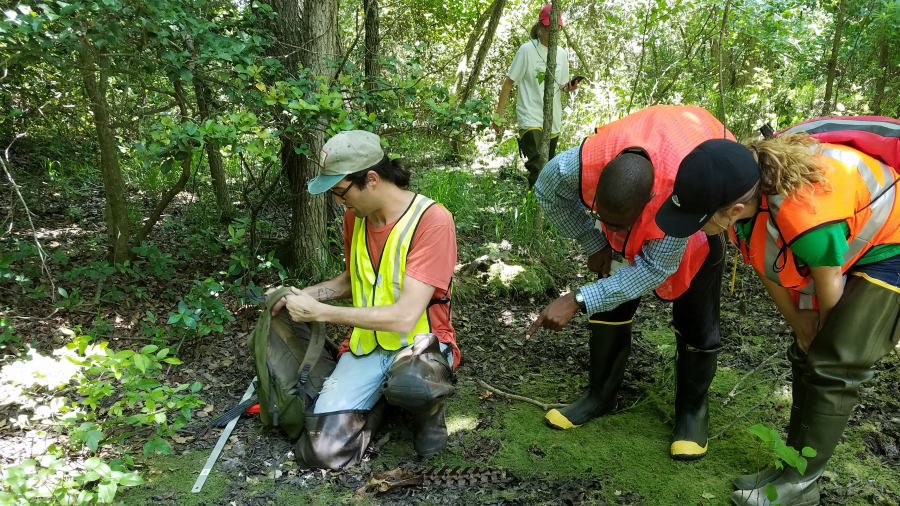
Sustainability is context-dependent and means many things to different people. What it takes to meet present needs without compromising the future will vary depending on one’s needs, social status, abilities, and more. Similarly, one can view the study of sustainability, or more generally, any socio-environmental (S-E) problem—such as those associated with water or food security—through different lenses, depending on a person’s perspectives and past experiences. The same goes for a person’s disciplinary background. Those trained in say anthropology or sociology will likely approach a problem with different theories and methodologies than say an ecologist or economist. While researchers often cite lexical differences as a barrier to interdisciplinary collaboration, there are many more. There can be vast differences among researchers and learners in their epistemic stances that determine what kind of knowledge they consider valid in research. There can be different, if not divergent, methods and methodologies, as well as variation in the extent to which research is theory-based or -motivated. But solving S-E problems is fundamentally an interdisciplinary exercise. All environmental problems are social problems, and many social problems are environmental in their origin. So, it would be rare for one expert to have the skills to tackle all aspects of a problem. That person can, however, acquaint themselves enough with the traditions of different disciplines to be able to know what types of other experts they need to bring to the table.
This lesson introduces learners to some of the common methods of different disciplines that are contributing to the study of, as well as finding solutions to, problems of S-E sustainability. Using the fields of anthropology, sociology, ecology, and economics, this lesson asks learners to explore journal articles to reveal the diversity of methods, types of information drawn upon, and positionality that researchers bring to the same S-E problem. It begins with a short PowerPoint presentation to alert learners to some of the types of approaches (e.g., hypothesis testing with quantitative data, ethnographic, critical discourse analysis, etc.), followed by instructions for the learning activity.
- Learn the difference between epistemologies and methods.
- Consider the wide range of methods that different disciplines bring to the study of S-E problems.
- Explore primary literature from multiple disciplines to identify types of information/data considered relevant to a problem and the methods used to study that problem.
In the below photo, four men are fishing in an undisclosed urban area. If you were a socio-environmental researcher, what type of data might you want to obtain to understand the role(s) that fishing plays in the lives of the men? And what methods would you use to collect the data? (Note to Instructor: Some learners will focus on the role of urban fishing in their nutrition, others on related poverty, or others on the potential health risks associated with consuming urban fish. All these responses [and more] are valid, but hopefully, learners will suggest interviewing the men and perhaps gathering environmental data, as well as social information).
The assignment assumes learners have access to academic journals on campus. It is helpful if the instructor provides links directly to the journals that are used in the lesson. The instructions are based on group learning; however, the instructor can easily adapt the directions for work at the individual level by having the learner work on their own, submit their findings to the instructor, share them with others online, or take turns with others to verbally share them with the whole group.
-
(15 min.) Show the PowerPoint presentation. You will need to go through this presentation fairly quickly (in 15 min), unless you have set aside two meeting sessions, of at least 50 min. each. The goal is not for learners to fully understand each method but just to help learners recognize words and categories of research methods and to introduce them to the variety of methods used by S-E researchers. Their assigned activity will help them understand what some of these mean in practice.
Document -
(5 min.) Divide the learners into four groups. Begin by first instructing learners that they will be exploring articles in journals. They should remember to log in to their campus library so that they can access information online during the session. Then assign each group to one of the following topics and associated journals (also in slide 13). The links below may need to be re-routed through the instructor’s campus library.
Group 1 – Drought Group 2 – Drought Group 3 – Urbanization Group 4 – Urbanization -
(25 min.) Split each of the four groups into teams of two to four learners. Each subgroup should find two studies from each assigned journal using the topic keyword. Learners should quickly peruse each article to find and note in a team-shared document the title of the paper, its authors, the journal, and URL of the article, as well as the following:
- The methods used
- The type of information used (theory, numeric data, texts, etc.)
- If they would consider the study qualitative, quantitative, or mixed
- The paper’s tone (e.g., level of formality); point of view (first, second, or third person); and dominant voice (active, passive, or both)
- One or two of the paper’s core findings
- The type(s) of images used (photos, graphs, tables, art, non, etc.)
If they would describe the study as explanatory, problem-solving, awareness-raising, or other.
-
(10 min.) Ask teams that have the same topic assignment to join together. This merger will result in two larger teams that represent all the journals used to explore the same topic. Have them collate their findings indicating which group found which articles (they can submit their list to the instructor for assessment as desired). The larger group should then select example articles that best illustrate the diversity of approaches/methods used on their topic and, time permitting, prepare a brief presentation (5 min.) to share with the whole assembly, ensuring that multiple participants in the group do the presentation.
-
(20 min.) Assemble all participants. Allow each of the groups to give their presentation. Follow up with discussion as desired. If there is not sufficient time for this activity, the instructor may ask the group to submit their larger groups’ results for assessment.
-
The Routledge Handbook of Research Methods for Social-Ecological Systems
This excellent, open access book provides chapters on almost all methods that S-E researchers use—more methods than this lesson covers. It is also useful because it indicates which disciplines most commonly use each method.
Biggs, R., de Vos, A., Preiser, R. et al. (Eds.). (2021). The Routledge Handbook of Research Methods for Social-Ecological Systems. Routledge Press, London. (Open access). https://doi.org/10.4324/9781003021339
-
How to use and assess qualitative research methods
This article is useful because it outlines why qualitative methods are useful, including how they can help us to understand findings and patterns, and it provides examples. While this is in a neurological journal, the basics are the same for all research.
Busetto, L., Wick, W., & Gumbinger, C. (2020). How to use and assess qualitative research methods. Neurological Research and Practice, 2, 14. https://neurolrespract.biomedcentral.com/articles/10.1186/s42466-020-00059-z
-
Learning across disciplines in socio-environmental problem framing
This article provides a framework for training researchers to integrate their knowledge across disciplines. It focuses on maximizing team learning, which emphasizes how to listen and learn to work effectively together regardless of disciplinary background. While not about disciplinary differences per se, the article touches on them and provides ideas that complement this lesson’s focus on introducing learners to different methods.
Pennington, D., Vincent, S., Gosselin, D., et al. (2022). Learning across disciplines in socio-environmental problem framing. Socio-Environmental Systems Modelling, 3: 17895. https://sesmo.org/article/view/17895
-
Creative interdisciplinary collaboration: A systematic literature
This article contributes to background knowledge for the lesson by reviewing why interdisciplinarity is important and how it links to creativity. It reviews types of knowledge diversity, emphasizes the importance of taking a problem-solving approach to sustainability problems, and includes extensive coverage of how to promote interdisciplinary creativity.
Moiranoa, R., Sáncheza, M.A., & Štěpánekb, L. (2020). Creative interdisciplinary collaboration: A systematic literature. Thinking Skills and Creativity, 35: 100626. https://doi.org/10.1016/j.tsc.2019.100626
